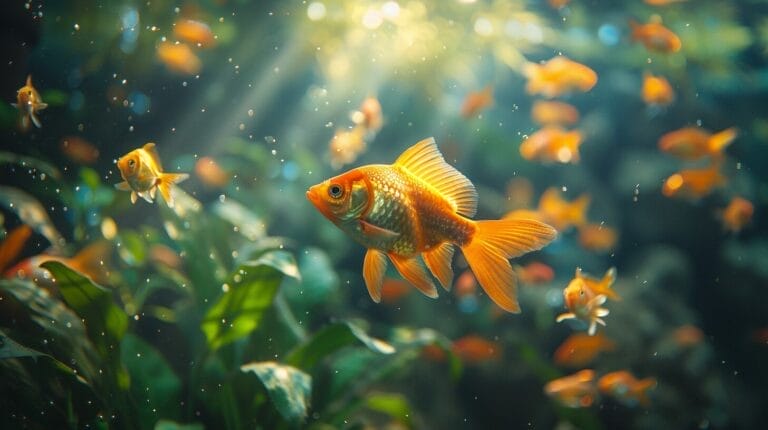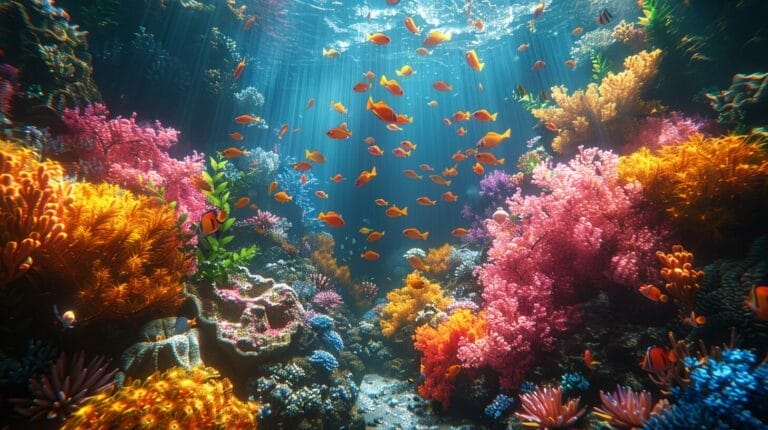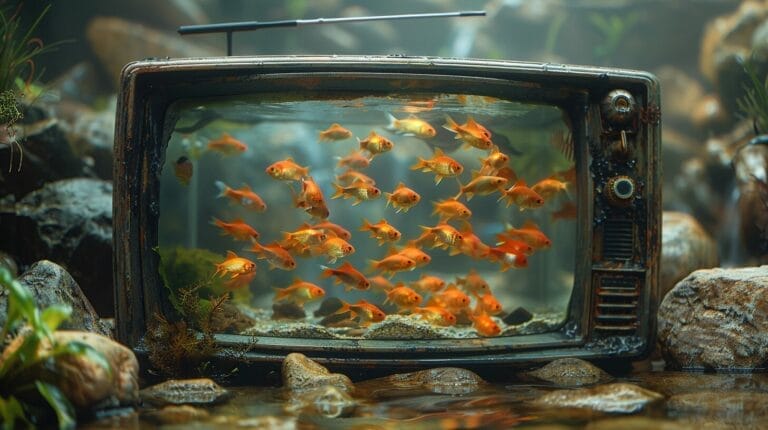How to Know if Guppy is Pregnant: Spotting Pregnant Guppy Signs

Guppies, brimming with life and color, are a favorite among aquarium enthusiasts across the globe. However, even seasoned aquarists may feel out of depth when faced with the challenge of discerning the subtle pregnancy signs in guppies. As someone with over a decade of fishkeeping experience, I can decipher these signs, and this knowledge is crucial to ensure the health and vitality of both the mother guppy and her impending brood.
Identifying a pregnant guppy calls for more than a casual glance. It requires keen attention to detail. Notably, changes in the gravid spot—the dark area near the female’s rear—around two weeks into pregnancy act as an invaluable clue.
Embark on this insightful journey into the captivating world of prenatal guppy behavior with me!
Key Takeaways
- Watch for a big, round belly and a dark gravid spot near the tail to tell if a guppy is pregnant.
- Pregnant guppies may change their swimming patterns, seek quiet spots, and eat less before birth.
- Set up a separate birthing tank with clean water and hiding places to ensure a safe birthing environment for the mother guppy.
Decoding the Basics: Is Your Guppy Pregnant?
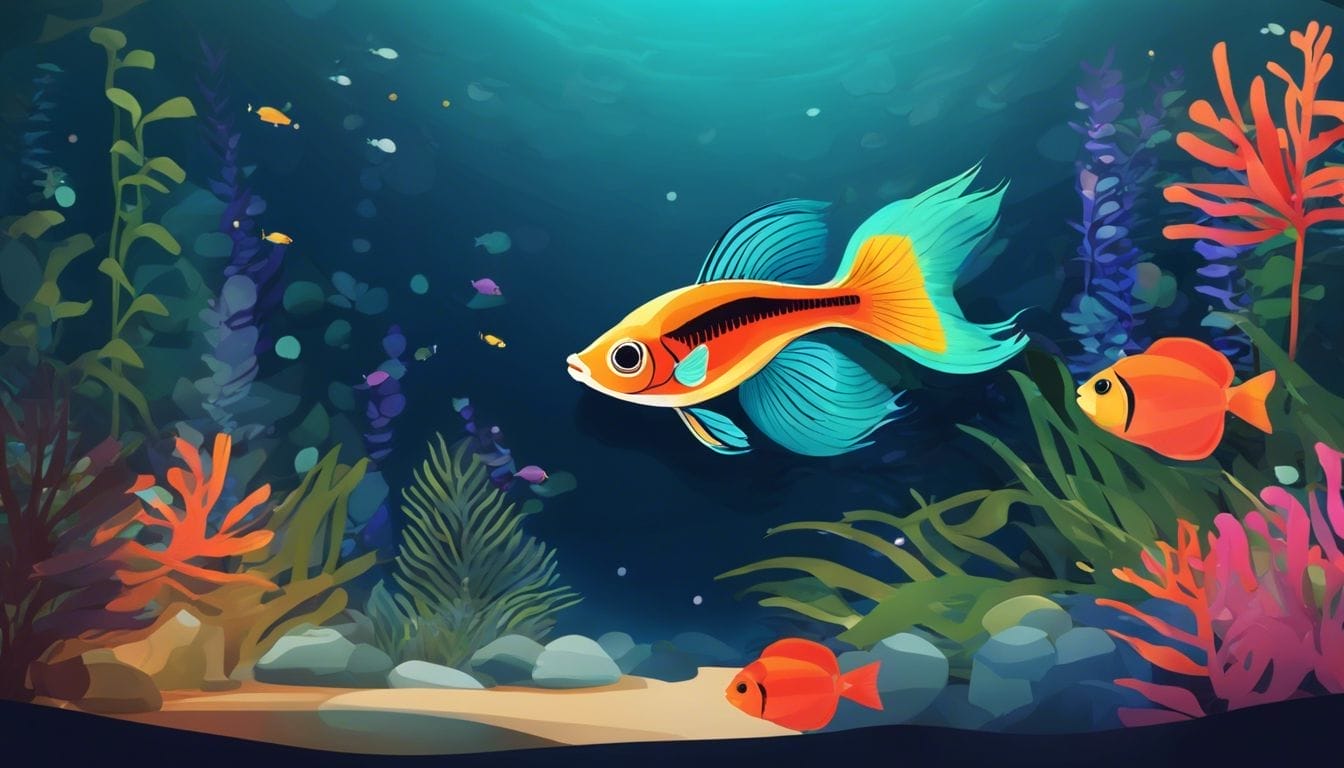
Recognizing a pregnant guppy can be simple once you know what signs to look for. Begin by differentiating between male and female guppies—females are typically rounder and duller in color compared to the vibrant males.
During pregnancy, a female guppy’s belly noticeably expands, and the gravid spot near her rear underbelly darkens as she gets closer to giving birth. The gestation period for a guppy is around 21-30 days, which validates regular observation to detect the telltale pregnancy signs.
Keep an observant eye, and you might soon witness a swarm of tiny fish exploring your aquarium!
Differentiating Between a Male and Female Guppy
It’s relatively easy to distinguish between male and female guppies, and it’s handy knowledge when determining if your guppy is pregnant. Female guppies are usually larger and less vibrant compared to their male counterparts. The females have a rounded anal fin, while males display a pointy one, used for mating. Females mostly exhibit plain or subtle hues, while male guppies impress with bright, shiny patterns.
Studying your guppy’s shapes will reveal these differences. Recognizing each fish in your tank means you’re primed to spot the initial signs of pregnancy in your female guppies.
Differentiating a Regular Guppy from a Pregnant One
After distinguishing males from females, the next step is discerning the difference between a regular guppy and a pregnant one. Watch your female guppy’s belly. If it looks larger than usual, she might be pregnant. This expanded belly often couples with a change in shape, as pregnant females tend to have rounder and bulkier bodies than their non-pregnant tankmates.
Moreover, be alert for changes in the gravid spot—the area near her rear tail. The gravid spot in pregnant guppies can darken and expand as they approach their birth due date.
These physical signs offer clear hints to recognize when your female fish is ready to share baby guppies with your aquarium community!
Average Duration of a Guppy Pregnancy
A guppy pregnancy lasts approximately a month or roughly 21 to 30 days for most females. However, this period can vary depending on the water temperature, the guppy’s age, or her genetic traits. Some guppies might carry their babies for as short as 20 days, while others could go up to 32 days before giving birth.
This gestation period allows the baby guppies to grow inside their mother until they are ready to swim independently. As your guppy approaches birthing, keep an observant eye and ensure optimum conditions in your tank to welcome new fry.
The Importance of the Gravid Spot in Identifying Pregnancy
The gravid spot—a distinguishing mark that expands and darkens as the baby fish grow inside the mother—provides a reliable way to determine if your guppy is pregnant. Located near her rear fin, the gravid spot is easy to locate once you know where to look.
Monitoring gravid spot changes helps prepare for the new fish that will soon enter your tank even before your guppy displays other signs like a bulging belly or behavioral changes.
Recognizing Physical Signs of a Pregnant Guppy
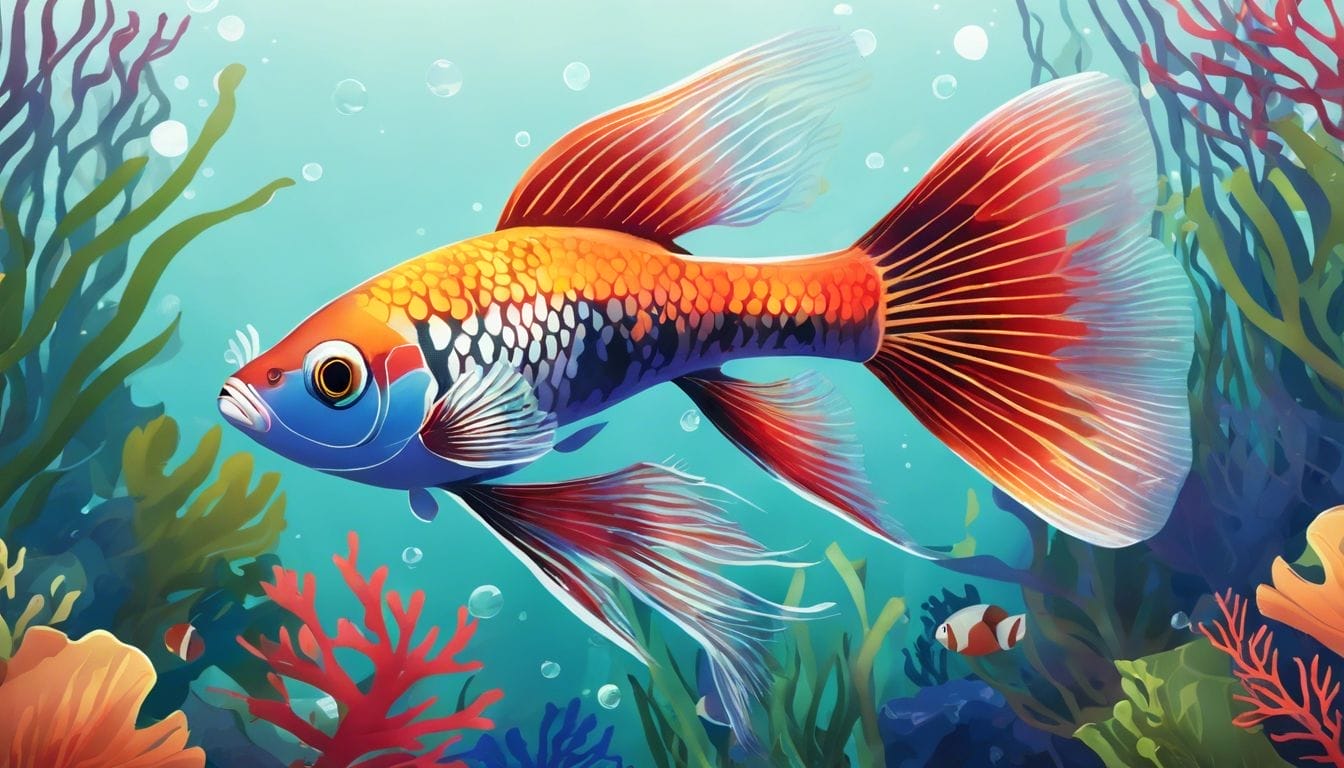
To discern if your guppy is pregnant, focus on her belly’s growth and the darkening of the gravid spot. These are sure signs of an imminent birth of guppy fry. Unravel more as we continue below, discussing the physical signs indicating that your guppy is expecting.
Watch how a guppy behaves during labor
Spotting a Swollen Belly: The Telltale Sign of a Pregnant Guppy
A guppy displaying a swollen belly is often times likely pregnant. This distinctive sign is evident as the fish’s middle expands. Female guppies can get impregnated early, with their bellies growing for approximately 20 to 32 days before they give birth.
You will spot more distinct changes as the pregnancy progresses. For instance, the gravid spot near her tail begins to darken and enlarge. These visible transitions are telltale signs that your guppy is soon to deliver.
Observing the fish side-on tells a lot. The pregnant guppy’s belly isn’t just fuller; it takes on a boxy appearance owing to the guppy fry inside. Not just their bellies, but their color also fades as they near birthing.
Keep a lookout for these physical changes—they can help you prepare for the arrival of new life in your aquarium!
How a Pregnant Guppy’s Belly Might Look
The belly of a pregnant guppy protrudes and rounds out, resembling a small balloon. The gravid spot near her tail, a classic pregnancy sign, also alters with time. It turns darker and visibly expands as the pregnancy advances.
Closely observing your guppy during this period will reveal these thrilling transformations—moments that any enthusiastic fish keeper will appreciate!
Significance of the Gravid Spot in Pregnant Guppies
The physical transformation in a pregnant guppy isn’t limited to her belly. The gravid spot holds a significant role too. This dark area near the female’s rear end enlarges and intensifies in color as she inches closer to birth.
It’s easy to spot on light-colored fish but might pose some difficulty with dark-hued ones.
The gravid spot changes vary with the progress of the pregnancy. It starts small and light, then gradually grows larger and darker as birthing approaches. This spot acts as an excellent guide to determine her gestation stage and estimated due date.
Monitoring this spot is one of the most reliable methods to confirm your guppy’s pregnancy accurately.
Untangling Pregnancy-Induced Behavioral Changes in Guppies
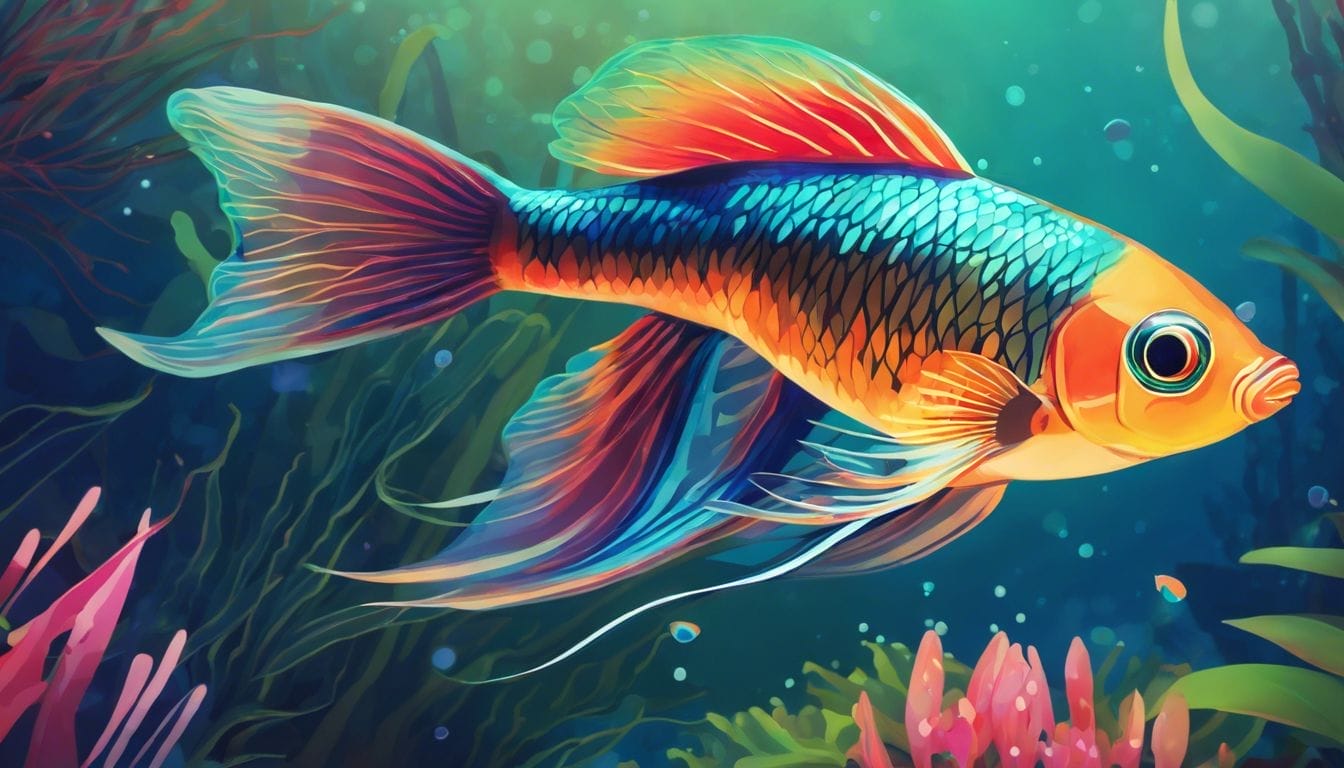
Pregnant guppies tend to display certain behavioral changes, such as spending more time hidden away or swimming in unusual patterns. These subtle shifts offer a glimpse into the fascinating transformation that accompanies guppy gestation.
Let’s explore these behavioral changes and what they intimate about your pet’s pregnancy stage. Observe her eating habits closely; a change in appetite often signifies impending birth.
Watch the swimming pattern of a pregnant guppy
Noticing Changes in Swimming Patterns During Guppy Pregnancy
Guppies relay their pregnancy status in various ways, and altered swimming patterns are one such hint. A pregnant female guppy might seclude more frequently, moving slower and seeking quiet hiding spots away from the others. This behavior results from the tire she experiences due to carrying the fry and her need for more rest than usual.
Consider these behavioral shifts as possible indicators that your guppy is preparing for giving birth. Such insights enable you to ensure a safe and healthy environment during this special phase.
Increased Seclusion—A Common Pregnancy Sign in Guppies
During pregnancy, female guppies often resort to solitary confinement, choosing quiet corners in the tank and avoiding interactions with other fishes. This behavioral shift is induced by the growing fry, making navigating the tank strenuous for the mother. Resting allows them to conserve energy for birthing.
Observe your guppy’s behavior closely if you sense she might be pregnant. Excessive solitude or resting could imply that she requires extra attention and care as she nears labor.
Unusual Eating Habits of a Pregnant Guppy
Pregnant guppies can exhibit altered eating habits. They might eat less or slow down compared the usual pace. While this change is normal in the pre-labor phase, it’s crucial to ensure the intake of nutritious food.
Feeding the pregnant guppy with healthy nourishments maintains her vigor and promotes growth in the fetus. Noticing these eating habits prepares you to establish a safe environment for the arriving guppies.
Preparing for a Guppy’s To-Be Birth
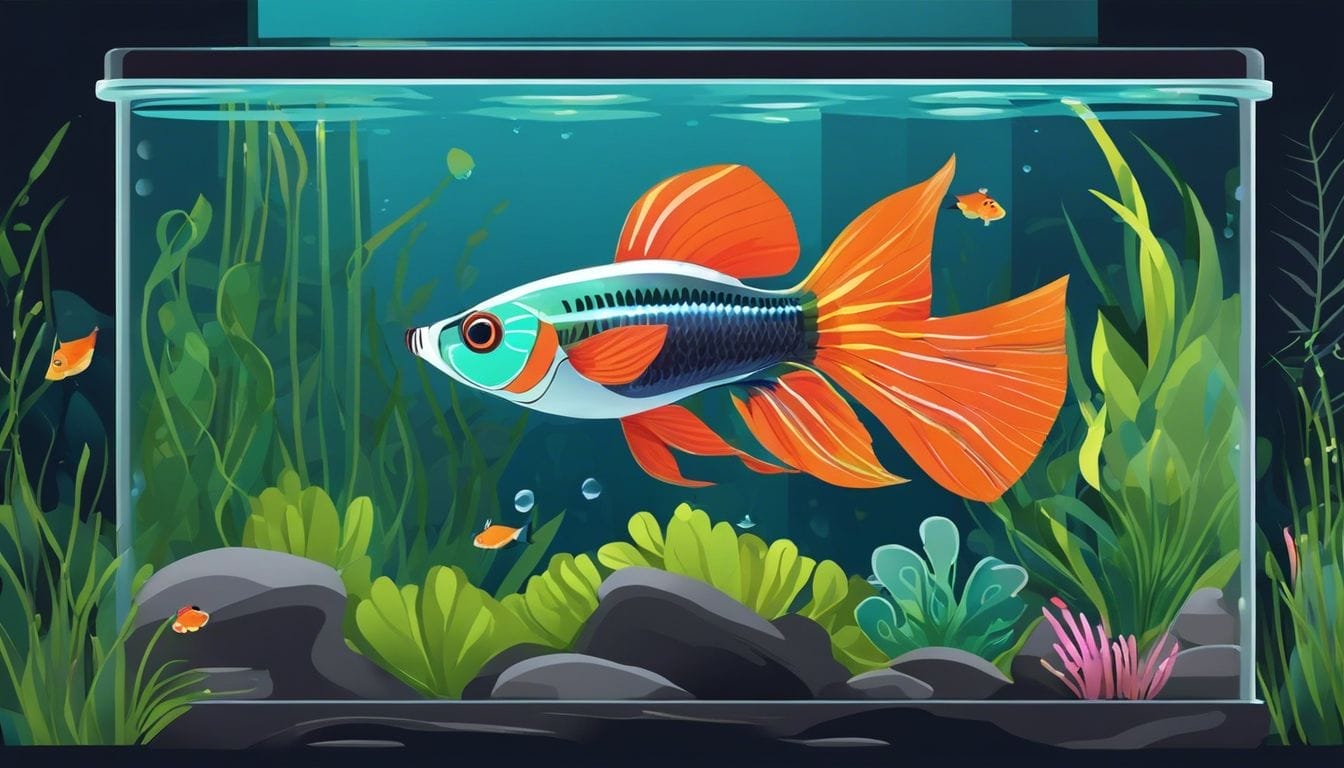
Confirming a guppy’s pregnancy prompts immediate action to prepare for the imminent arrival of the fry. Setting up a separate birthing tank provides an amiable environment for the mother to deliver without stress.
Creating a controlled water environment through a separate breeding tank affords additional benefits like monitoring water conditions specific to the mother and fry.
Splendid outcomes await when both the mother guppy and her babies are given an optimal environment to thrive during this delicate phase.
Setting Up a Separate Birthing Tank
Creating a separate birthing tank for your pregnant guppy is a wise move. This setup guarantees safety and a stress-free birth for the mother, and a safe start for the babies. Follow these steps to set up a birthing tank:
- Choose an ideal tank size, preferably ranging from 5 to 10 gallons.
- Fill the tank with clean water. Ensure that the water temperature and pH level match your primary aquarium conditions.
- Introduce a gentle filter that maintains cleanliness without creating harmful currents for newborn fry.
- Add plants or decorations to create hiding spots. Newborn guppies will need places to hide after birth.
- Use a divider or breeding box if you prefer keeping the mother in the main tank until delivery.
- Monitor the water conditions vigilantly. Both the mother and the babies need an environment with good water quality.
Breeding Tank Vs. Community Tank: The Ideal Pick
As your special breeding tank is ready, you may ponder whether to use this breeding tank or keep the pregnant guppy in the community tank.
While the breeding tank allows close observation of the pregnant guppy and her fry, keeping your pregnant guppy in the community tank can keep her happy and calm, as it allows her to stay among familiar faces. However, this might expose the susceptible fry to potential threats from other fishes.
If the community tank option is selected, consider adding plenty of hiding spots like plants. This provides safety to the fry. After all, the key to ensuring happy and healthy fish is making decisions that are in their best interest.
Introducing a Breeding Box to Safeguard the Fry
A breeding box is an excellent tool to protect baby guppies from possible threats post-birth. This box goes inside your main tank, keeping the fry separated and safe from larger fishes that might harm them.
The box contains tiny openings that allow water circulation but keep the fry from swimming out. This breeding box ensures that the newborn fry have access to clean water and get acclimated without the risk of being harmed or consumed by adult guppies or other fish.
Incorporating a breeding box in your setup gives the newborn guppies a headstart in life!
Can Pregnant Guppies Be Compatible Tank Mates for Axolotls?
Can pregnant guppies be compatible tank mates for Axolotls? The axolotl tank mates: fish compatibility guide recommends avoiding this combination. Pregnant guppies require a stable and peaceful environment, while axolotls have a tendency to be aggressive towards smaller fish. It is best to provide separate tanks to ensure the safety and well-being of both species.
Do Scuds Have any Impact on the Pregnancy of Guppies?
The diet of freshwater scuds can affect the pregnancy of guppies. If guppies consume scuds, it can lead to various health issues for the pregnant guppies. The scuds’ diet can have an impact on the development and health of the unborn guppy offspring.
Managing a Guppy’s Birthing and Caring for Her Post-Birth

During a guppy’s birth, it’s paramount to navigate this delicate process with precision. Also, there is a need to understand post-delivery practices that help your female guppy recuperate and thrive. This knowledge is essential for every aquarist aspiring for a harmonious tank environment where life burgeons.
Let’s delve deeper into the intricacies of birthing and the requisite care for both the mother and the fry—a process that promises to be a thrilling learning experience.
Decoding the Birthing Process in Guppies
Guppy birth is an exhilarating event. When ready to give birth, a pregnant guppy will seek a quiet spot in the tank. Notable body contractions and a box-like belly shape indicate the imminent birth of each fry.
This process may span several hours, with the guppy birthing up to 200 baby guppies! The fry might appear still for a moment immediately after birth but will soon start swimming around.
Once your guppy births, she will need rest. Maintain clean water and provide quality food to help her recover. The newborn fry are minuscule and risk getting consumed by other fish, so it’s wise to provide them with a separate space or add plant-based hiding spots to your tank.
Ensuring proper care for both the mother and the fry assures a healthy start in their aquatic life!
Caring for the Female Guppy Post-Birth
Post-birth, providing the female guppy with optimal care is of utmost importance. She will be exhausted and will need a quiet retreat where she can rest without disturbance from other fish. Shifting her to a separate area will prevent stress and aid recovery.
Feeding her protein-rich food like high-quality flake food or frozen meals will revitalize her health post-birthing. It is vital to ensure she is consuming adequate food and is in pink health as she regains her normal strength.
Handling Male Guppies Post-Birth
Caring for a pregnant guppy after birthing is crucial, but we should not overlook the male guppies’ role. Male guppies can sometimes be aggressive towards pregnant guppies and their fry. They don’t participate in caring for the young, but play a critical role in mating. To maintain a peaceful tank environment, the best option may be to separate male guppies from the rest.
This separation prevents potential aggressive behavior from the males towards the mother and her fry. The baby guppies will be able to develop better without stress from the males. Observation is a key tool to ensure peace among all your guppy friends!
Nurturing Baby Guppy Fry: A Comprehensive Guide

Once the excitement of guppy birth subsides, you must focus on ensuring these tiny newcomers receive specialized care to flourish in their aquatic world. This stage of life for the baby guppies demands a meticulous approach, involving a gradual dietary transition from infusoria to finely crushed flake foods, and eventually to larger and more nutritious alternatives like brine shrimp.
Having sufficient precautionary measures, like providing a separate breeding box or sectioning part of the tank, is beneficial. This safeguards the fry from potential threats and provides them with a safe space to grow.
Regularly monitoring water conditions is a must since pristine and stable parameters can prevent potential diseases.
Navigating this stage of guppy fry growth requires patience and vigilance, as their nutritional needs rapidly evolve.
Understanding the Needs of Guppy Fry
Guppy fry are miniscule in size and require special care. Their diet initially consists of tiny foods like baby brine shrimp or crushed flake foods which are easy to consume.
A pregnant guppy can produce a sizable brood sometimes numbered at 100-200 at once! It takes around 2-3 months for these tiny guppies to mature and start producing fry of their own.
Maintaining tank cleanliness and ideal water conditions ensures your fry develop healthily. Regular but gradual water changes prevent shocking the guppy fry with abrupt condition changes. Feeding them adequately with the right sized foods aids their healthy growth.
Here’s wishing your growing guppy family all the health and happiness!
Feeding and Caring for the Fry
Newborn fry feed on small food items like crushed algae or infusoria, which provide ample nutrients for their early growth stages. As the fry grow bigger, introduce them to newly hatched brine shrimp. This live food is an excellent dietary addition because it triggers predatory instincts in the fry.
Continuing to feed young guppies as they grow is essential. Gradually replace the brine shrimp diet with high-quality pellet foods designed for young guppies. Ensure that these pellets are small enough for the growing guppies to consume easily.
Maintaining clean water free from harmful substances and providing fresh water supply aids the fry in their maturation.
Protecting Newborn Fry from Larger Fish in the Tank
Little guppy fries are tiny and could easily become a meal for larger fish in your tank. To avoid this, consider placing the fry in a separate tank right after they’re born. This isolated space is like a secured nursery where they can grow without the fear of falling prey to larger fishes.
Feed your baby guppies a diet of soft algae initially, then transition them to small pellets as they grow older. This diet regime aids their healthy growth.
Offering the fry a safe space and appropriate nutrition are key factors that give them the best chance of surviving and growing into vibrant adult guppies. Now let’s discuss feeding recommendations for fry in detail.
Conclusion
You’ve learned how to identify a pregnant guppy and the changes to keep an eye out for. These useful signs and tips can help you ensure the health of the mother guppy and her babies. Enjoy the amazing marvel of new marine life in your home aquarium!
Frequently Asked Questions
- How can I tell if my guppy fish is pregnant?
A pregnant guppy typically has an enlarged belly and a dark gravid spot near the tail. This spot darkens as the pregnancy progresses.
- What are common signs that a female guppy is having babies soon?
A larger and box-like belly shape coupled with a change in her normal behavior—pregnant guppies often stay solitary—are signs she is close to birthing.
- How long does it take for a guppy to have babies?
A pregnant guppy usually carries her babies for about three weeks to a month before they’re born.
- Should I put my pregnant guppy in a separate tank?
Yes, a separate tank is ideal for pregnant guppies as it provides a stress-free environment for birthing and safeguards the newborn fry from potential threats.
- Will I know when my guppy is going into labor?
Yes. Visible signs like more time spent hidden away or visible body contractions indicate that your guppy is nearing birth.
- What do I feed the baby guppies after birth?
Baby guppies need small, nutrient-rich food. Start with offerings like infusoria, then transition them to finely crushed flake food or baby brine shrimp, which are a suitable size for them to consume.




